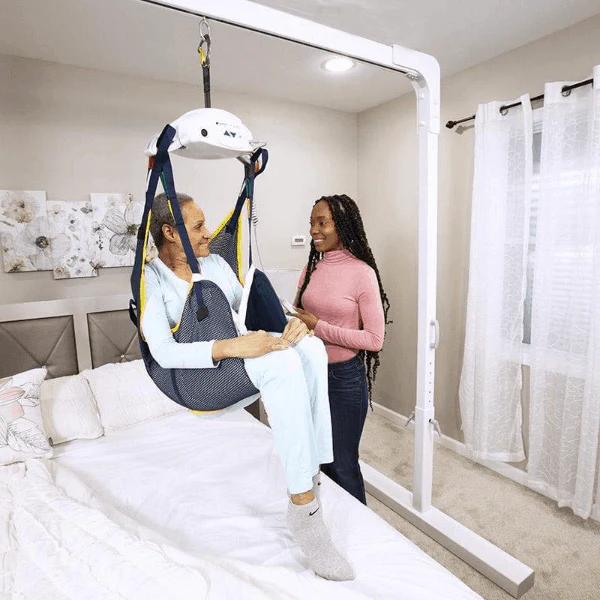Caring for individuals with disabilities often comes with unique challenges, especially when it comes to mobility. One innovative solution that has transformed caregiving is the ceiling lift for disabled individuals. This system provides an efficient, safe, and convenient way to transfer individuals from one place to another within a room or facility.

This article explores the benefits of ceiling lifts, how they work, factors to consider when choosing one, and tips for proper use and maintenance.
What Is a Ceiling Lift for Disabled Individuals?
A ceiling lift is an assistive device designed to help caregivers transfer individuals with mobility challenges. Mounted on a track system, it allows for seamless movement across a room, such as from a bed to a wheelchair or from a wheelchair to a bath.
The system typically includes:
- A track or rail system installed on the ceiling.
- A motorized lift unit that moves along the track.
- A sling or harness for securely supporting the person during transfers.
This equipment is widely used in homes, hospitals, and assisted living facilities to enhance safety and ease for both the caregiver and the individual with a disability.
Benefits of a Ceiling Lift for Disabled Individuals
1. Increased Safety
Ceiling lifts reduce the physical strain on caregivers, lowering the risk of injuries caused by manual lifting. For individuals with disabilities, the secure harness or sling minimizes the risk of falls during transfers.
Read too: Kitchen Lighting For A Vaulted Ceiling: Illuminating Your Space with Style and Functionality
2. Improved Accessibility
The lift system allows individuals to access different areas of their home or facility effortlessly, enhancing independence and quality of life.
3. Enhanced Comfort
Transfers are smoother and more comfortable compared to manual lifting or traditional transfer aids like transfer boards.
4. Space-Saving Design
Unlike floor-based lifts, ceiling lifts do not occupy floor space, making them ideal for smaller rooms.
5. Support for Caregivers
Caregivers experience less physical fatigue, allowing them to focus on providing better care without risking their own health.
Types of Ceiling Lifts
When considering a ceiling lift for disabled individuals, understanding the different types available is essential:
1. Fixed Ceiling Lifts
- Features: Permanently installed track system.
- Best For: Long-term use in a single location.
- Advantages: Highly durable and reliable for frequent use.
2. Portable Ceiling Lifts
- Features: Removable motor unit that can be moved between tracks.
- Best For: Flexible use across multiple rooms or locations.
- Advantages: Cost-effective and versatile.
3. Hybrid Systems
- Features: Combines fixed and portable features.
- Best For: Facilities needing both permanent and flexible options.
- Advantages: Greater adaptability without compromising stability.
Factors to Consider When Choosing a Ceiling Lift
Selecting the right ceiling lift involves evaluating several factors:
1. Weight Capacity
Ensure the lift can safely accommodate the individual’s weight. Most systems support between 300 to 600 pounds, but bariatric models can handle higher capacities.
2. Room Layout
The track system must be tailored to the room’s design. Common layouts include straight tracks, curved tracks, and room-covering systems (H-frame).
3. Ease of Operation
Look for user-friendly controls and mechanisms that both caregivers and users can operate with ease.
4. Power Source
- Battery-Powered: Offers portability and backup during power outages.
- Electric-Powered: Provides continuous operation without needing battery replacements.
5. Budget
Consider the total cost, including installation, maintenance, and any additional features like remote control or extended tracks.
6. Installation Requirements
Some homes may require structural modifications to support the track system. Ensure the installation process is compatible with your building structure.
Installation Process
1. Assessment
A professional evaluates the space to determine the best track design and placement.
2. Track Installation
Tracks are mounted to the ceiling using secure brackets, ensuring stability.
3. Motor and Sling Setup
The motor unit is attached to the track, and slings are installed for safe transfers.
4. Testing and Training
The system is thoroughly tested for safety, and caregivers are trained on proper operation and maintenance.
Proper Usage Tips for Ceiling Lifts
To maximize the benefits of a ceiling lift for disabled individuals, follow these best practices:
1. Perform Regular Inspections
Check for wear and tear on tracks, slings, and the motor to ensure safe operation.
2. Use the Correct Sling
Different slings are designed for various purposes, such as bathing, sitting, or lying down. Choose the appropriate type for each transfer.
3. Adhere to Weight Limits
Overloading the lift can lead to equipment failure and potential injuries.
4. Train All Users
Anyone operating the lift should receive proper training to prevent misuse or accidents.
5. Maintain Cleanliness
Keep slings and tracks clean to prevent dirt buildup and ensure a hygienic environment.
Cost of Ceiling Lifts
The cost of a ceiling lift varies depending on the type, track design, and additional features. Here’s an overview:
- Portable Systems: $2,000–$5,000
- Fixed Systems: $5,000–$10,000 (including installation)
- Bariatric Models: $10,000 or more
Many suppliers offer financing options or payment plans to make these devices more accessible. Additionally, check for insurance coverage or government assistance programs that may help offset costs.
Enhancing Independence with a Ceiling Lift for Disabled Individuals
The integration of a ceiling lift into a home or care facility transforms the caregiving experience, providing both safety and dignity to individuals with disabilities. These systems empower users to access their surroundings with ease, fostering greater independence and confidence.
Whether for personal use or professional caregiving, a ceiling lift for disabled individuals is an investment in comfort, safety, and quality of life.
